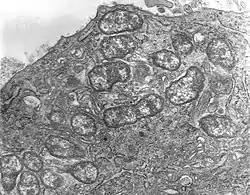Orientia tsutsugamushi
Orientia tsutsugamushi (del japonés tsutsuga "enfermedad" y mushi "insecto") es el agente causal de la fiebre de los matorrales,[1] siendo vectores y reservorio probablemente ácaros del género Leptotrombidium).[2][3] Es un parásito intracelular obligado, es decir que necesita infectar a una célula eucariota para multiplicarse. Es una bacteria gram negativa, aunque no se tiñe bien con la tinción de Gram, prefiriéndose la tinción de Giménez. Hay muchos serotipos descritos: Karp ( aproximadamente el 50% de todas las infecciones), Gilliam (25%), Kato (menos del 10%), y Kawasaki,[3][4] pero existe una enorme variabilidad, con ocho serotipos documentados en Malasia,[5] y otros muchos aún notificándose.[6][7][8] La infección con un serotipo no confiere inmunidad frente a otros serotipos (no hay inmunidad cruzada).
| Orientia | ||
|---|---|---|
 Orientia tsutsugamushi | ||
| Taxonomía | ||
| Dominio: | Bacteria | |
| Filo: | Proteobacteria | |
| Clase: | Alpha Proteobacteria | |
| Orden: | Rickettsiales | |
| Familia: | Rickettsiaceae | |
| Género: | Orientia | |
| Especie: |
O. tsutsugamushi (Hayashi 1920) Tamura et al. 1995 | |
Microbiología
La bacteria fue en principio categorizada en el género Rickettsia,[1] pero actualmente está clasificada en un género aparte, Orientia, en el cual es la única especie.[9]
Mide 0.5 µm de ancho and 1.2 a 3.0 µm de largo. Es muy virulento y sólo puede ser manipulado en laboratorios con nivel de seguridad 3.[10]
Terapia antimicrobiana
O. tsutsugamushi es sensible in vitro a doxiciclina, rifampicina and azitromicina. Es resistente de forma innata a todos los antibióticos betalactámicos (por ejemplo, penicilina) porque carece de pared celular de peptidoglucano.[11] Aminoglucósidos (por ejemplo, gentamicina) son también inefectivos, puesto que se trata de un parásito intracelular, y los aminoglucósidos no actúan dentro de la célula.
Referencias
- Watt G, Parola P (octubre de 2003). «Scrub typhus and tropical rickettsioses». Curr Opin Infect Dis 16 (5): 429-36. PMID 14501995. doi:10.1097/00001432-200310000-00009. Archivado desde el original el 11 de marzo de 2012. Consultado el 16 de abril de 2013.
- Traub R, Wisseman CL Jr (1974). «The ecology of chigger-borne rickettsiosis (scrub typhus)». J Med Entomol 11 (3): 237-303. PMID 4212400.
- Kelly DJ, Fuerst PA, Ching W-M, Richards AL (2009). «Scrub typhus: The geographic distribution of phenotypic and genotypic variants of Orientia tsutsugamushi». Clin Infect Dis 48 (s3): S203-30. PMID 19220144. doi:10.1086/596576.
- Yamamoto S, Kawabata N, Tamura A, et al. (1986). «Immunological properties of Rickettsia tsutsugamushi, Kawasaki strain, isolated from a patient in Kyushu». Microbiol Immunol 30 (7): 611-20. PMID 3095612.
- Shirai A, Tanskul PL, Andre, RG, et al. (1981). «Rickettsia tsutsugamushi strains found in chiggers collected in Thailand». Southeast Asian J Trop Med Public Health 12 (1): 1-6. PMID 6789455.
- Kang JS, Chang WH (1999). «Antigenic relationship among the eight prototype and new serotype strains of Orientia tsutsugamushi revealed by monoclonal antibodies». Microbiol Immunol 43 (3): 229-34. PMID 10338191.
- Bakshi D, Singhal P, Mahajan SK, Subramaniam P, Tuteja U, Batra HV (2007). «Development of a real-time PCR assay for the diagnosis of scrub typhus cases in India and evidence of the prevalence of new genotype of O. tsutsugamushi». Acta Trop 104 (1): 63-71. PMID 17870041. doi:10.1016/j.actatropica.2007.07.013.
- Parola P, Blacksell SD, Phetsouvanh R, et al. (2008). «Genotyping of Orientia tsutsugamushi from Humans with Scrub Typhus, Laos». Emerg Infect Dis 14 (9): 1483-1485. PMC 2603112. PMID 18760027. doi:10.3201/eid1409.071259.
- Tamura A, Ohashi N, Urakami H, Miyamura S (1995). «Classification of Rickettsia tsutsugamushi in a new genus, Orientia gen. nov., as Orientia tsutsugamushi comb. nov». Int J Syst Bacteriol 45 (3): 589-591. PMID 8590688. doi:10.1099/00207713-45-3-589.
- Centers for Disease Control and Prevention (1999). «Section VII-E: Rickettsial Agents». Biosafety in Microbiological and Biomedical Laboratories (BMBL) (4th edición). Washington DC: U.S. Government Printing Office. pp. 149-53. Consultado el 13 de marzo de 2009.
- Amano K, Tamura A, Ohashi N, Urakami H, Kaya S, Fukushi K (1987). «Deficiency of peptidoglycan and lipopolysaccharide components in Rickettsia tsutsugamushi». Infect Immun 55 (9): 2290-2292. PMC 260693. PMID 3114150.